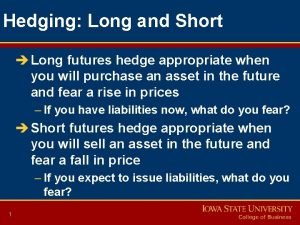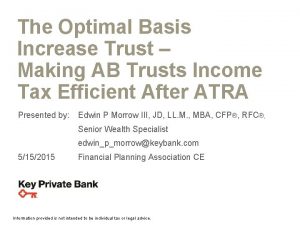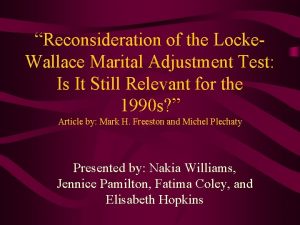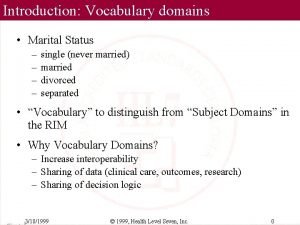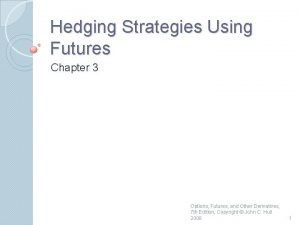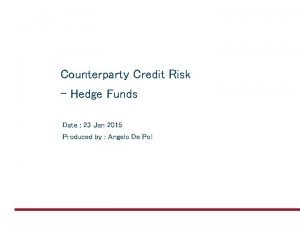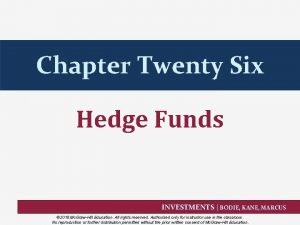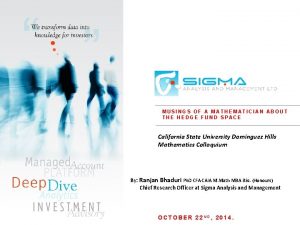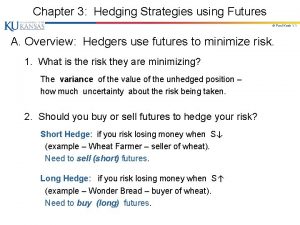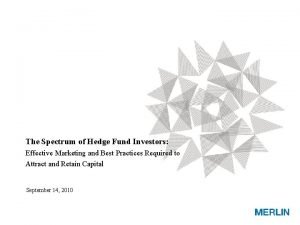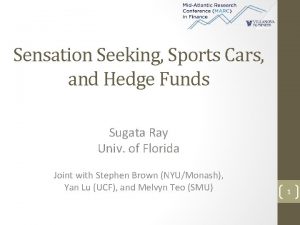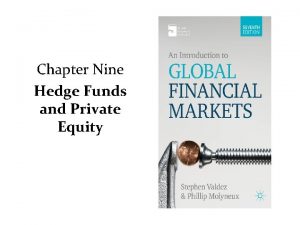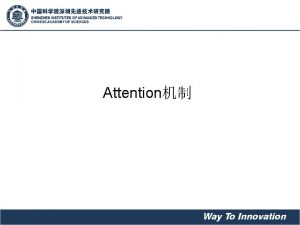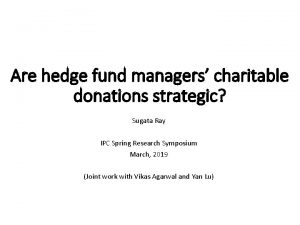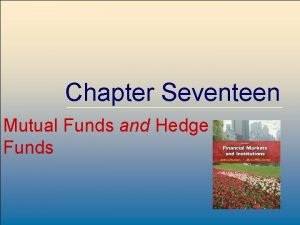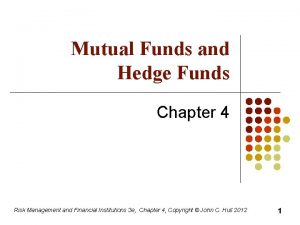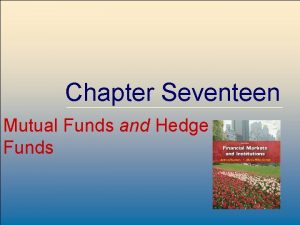Limited Attention Marital Events and Hedge Funds Sugata












![Empirical results: Univariate results [event study-marriage] Abnormal returns around marriage 3 2. 5 2 Empirical results: Univariate results [event study-marriage] Abnormal returns around marriage 3 2. 5 2](https://slidetodoc.com/presentation_image_h/02b7df4204fdc94df22890359ac705e4/image-13.jpg)
![Empirical results: Univariate results [event study-divorce] Abnormal returns around divorce 2 1. 5 1 Empirical results: Univariate results [event study-divorce] Abnormal returns around divorce 2 1. 5 1](https://slidetodoc.com/presentation_image_h/02b7df4204fdc94df22890359ac705e4/image-14.jpg)
![Empirical results: Multivariate results [event study] Table 4: Multivariate regression analysis • Sample includes Empirical results: Multivariate results [event study] Table 4: Multivariate regression analysis • Sample includes](https://slidetodoc.com/presentation_image_h/02b7df4204fdc94df22890359ac705e4/image-15.jpg)
![Empirical results: Multivariate results [matched sample] Table 5: Multivariate regression analysis with matched sample Empirical results: Multivariate results [matched sample] Table 5: Multivariate regression analysis with matched sample](https://slidetodoc.com/presentation_image_h/02b7df4204fdc94df22890359ac705e4/image-16.jpg)












- Slides: 28

Limited Attention, Marital Events, and Hedge Funds Sugata Ray Joint work with Yan Lu (UCF) and Melvyn Teo (SMU) 1

“Almost a quarter of British motorists admit that they have been so distracted by roadside billboards of semi-naked models that they have dangerously veered out of their lanes. ” -Reuters (London) 21 November 2005 2

Motivation: Limited attention on limited attention • There has been limited attention on the topic of limited attention. • Research has shown that limited attention cause market participants to • underreact to earnings announcements (Hirshshleifer, Lim, and Teoh, JF 2009; Della. Vigna and Pollet, JF 2009) • purchase top volume stocks (Barber and Odean, RFS 2008) • neglect economic links between consumer and supplier firms (Cohen and Frazzini, JF 2008) • gloss over longer term demographic data (Della. Vigna and Pollet, AER 2007) • However, the extant literature has yet to show the impact of limited attention on investment performance. 3

“One of my No. 1 rules as an investor is as soon as I find out that a manager is going through divorce, I redeem immediately. Because the emotional distraction that comes from divorce is so overwhelming. … You can automatically subtract 10 to 20 percent from any manager if he is going through divorce. ”” -Paul Tudor Jones II, May 2013 4

Motivation • Anecdotal evidence suggests that hedge fund investors value a fund manager’s ability to stay focused in the investment game. • Funds managers take to extreme measures to focus (e. g. Ray Dalio meditates; SAC (now Point 72) had an on-staff psychiatrist) • Divorces and marriages are intense personal events, taking away from attention and focus at work • We test the importance to investment management of the ability to stay focused by analyzing the impact of marital events on hedge fund manager performance. 5

Research questions • How do marital events such as getting married or getting divorced impact the investment performance of hedge fund managers? • Are busier managers affected more? • What are the channels of performance impacts? (previewing the results, how do distracted managers destroy value? ) 6

Related literature • Division of labor in marriage increases productivity: Becker (JPE 1973), Korenman and Neumark (JHR 1991), Cornaglia and Feldman (WP 2011), and Bellas and Toutkoushian (RHE 1999) • Limited attention and earnings: e. g. Hirshsleifer, Lim, and Teoh (JF 2009) - Earnings announcements crowded out by other announcements, Della. Vigna and Pollet (JF 2009) - Friday Earnings announcements • Active fund management: e. g. Cremers and Petajisto (RFS 2009) • Hedge fund performance: e. g. Teo (RFS 2009), Daniel, Naik, and Agarwal (JF 2009), Bollen and Poole (JFQA 2008, JF 2009). • “Limited attention” and corporate finance: e. g. CEO vacation travel (Yermack, JFE 2014), CEO family deaths (Bennedsen, Perez-Gonzalez, and Wolfenzon, WP 2010), CEO hospitalizations (Bennedsen, Perez. Gonzalez, and Wolfenzon, WP 2012) 7

Data and methodology • • Sample period from January 1994 to December 2012 • Hedge fund manager marital records from Lexis-Nexis court searches, supplemented by other internet sources. Records are publicly available for 13 U. S. states. • We observe 857 marriages and 251 divorces for 786 hedge fund managers. • Hedge fund holdings data from Thomson Financial 13 -F filings data for fund families with at least US$100 m of long U. S. equity holdings Hedge fund performance data are from TASS, Morningstar, HFR, and Barclay Hedge. After removing duplicate share classes we have 26, 811 funds of which 15, 550 are live and 11, 261 are dead. 8

Data and methodology Figure 1: Distribution of marriages across our sample of U. S. states (1994 -2012) Virginia 2% Pennsylvania Ohio 1% North Carolina 2% Nevada 3% Kentucky 1% 0% Georgia 4% Texa s 16% Florida 17% California 25% Connecticut 25% Colorado 4% 13 states publicly disclose marital records. The remaining states do not disclose marriage and divorce data publicly. For example, New York State restricts access to marriage records to “the spouses [and] other persons who have a: (1) documented judicial or other proper purpose or (2) New York State Court Order. ” 9

Data and methodology Figure 2: Distribution of divorces across our sample of U. S. states (1994 -2012) Ohio North Carolina 1% Nevada 4% Georgia 1% 4% Virginia Arizona 3% 1% Texa s 12% Florida 27% California 32% Connecticut 16% 10

Data and methodology • We adopt an event study framework to analyze the impact of marital events on fund manager performance • Our event window starts 3 months before and ends 3 months after the date of the marital event. The pre-event window starts 2 years prior to the event and ends 3 months before the event. The post-event window starts 3 months after the event and ends 2 years after the event. • We adjust for risk using the Fung and Hsieh (FAJ 2004) sevenfactor model and using the past 24 months of fund returns to generate rolling betas. • We employ multivariate regressions that control for size (Berk and Green, JPE 2004), redemption terms (Aragon, JFE 2007), incentive fees (Agarwal, Daniel, and Naik, JF 2009), and fund age (Aggarwal and Jorion, JFE 2010) 11

Data and methodology cont’d • To control for endogeneity concerns, we also perform a matched sample analysis • Each fund in the treatment group is matched with a fund in the control group by minimizing the absolute difference in performance during the "Before" period. • Example of endogeneity concern: • Fund does well, manager gets married because fiance/fiancee is excited about good performance/fees, performance mean reverts • Matched sample avoids this, since post marriage performance will be compared to another fund that does well, but where the manager doesn’t get married 12
![Empirical results Univariate results event studymarriage Abnormal returns around marriage 3 2 5 2 Empirical results: Univariate results [event study-marriage] Abnormal returns around marriage 3 2. 5 2](https://slidetodoc.com/presentation_image_h/02b7df4204fdc94df22890359ac705e4/image-13.jpg)
Empirical results: Univariate results [event study-marriage] Abnormal returns around marriage 3 2. 5 2 1. 5 Before=1. 0 1 0. 5 0 Event=0. 598 After=0. 760 -24 -23 -22 -21 -20 -19 -18 -17 -16 -15 -14 -13 -12 -11 -10 -9 -8 -7 -6 -5 -4 -3 -2 -1 0 1 2 3 4 5 6 7 8 9 10 11 12 13 14 15 16 17 18 19 20 21 22 23 24 -0. 5 -1 -1. 5 13
![Empirical results Univariate results event studydivorce Abnormal returns around divorce 2 1 5 1 Empirical results: Univariate results [event study-divorce] Abnormal returns around divorce 2 1. 5 1](https://slidetodoc.com/presentation_image_h/02b7df4204fdc94df22890359ac705e4/image-14.jpg)
Empirical results: Univariate results [event study-divorce] Abnormal returns around divorce 2 1. 5 1 Before=0. 750 0. 5 0 After=0. 559 -24 -23 -22 -21 -20 -19 -18 -17 -16 -15 -14 -13 -12 -11 -10 -9 -8 -7 -6 -5 -4 -3 -2 -1 0 1 2 3 4 5 6 7 8 9 10 11 12 13 14 15 16 17 18 19 20 21 22 23 24 Event=0. 101 -0. 5 -1 14
![Empirical results Multivariate results event study Table 4 Multivariate regression analysis Sample includes Empirical results: Multivariate results [event study] Table 4: Multivariate regression analysis • Sample includes](https://slidetodoc.com/presentation_image_h/02b7df4204fdc94df22890359ac705e4/image-15.jpg)
Empirical results: Multivariate results [event study] Table 4: Multivariate regression analysis • Sample includes marrying/divorcing funds and other funds in the states for which we have data • Results displayed are monthly – so marrying fund managers underperform matched peers by 0. 61% (or about 7. 3% annualized alpha) during the 6 months around the marriage • Basically – both marriages and divorces are bad for fund alpha 15
![Empirical results Multivariate results matched sample Table 5 Multivariate regression analysis with matched sample Empirical results: Multivariate results [matched sample] Table 5: Multivariate regression analysis with matched sample](https://slidetodoc.com/presentation_image_h/02b7df4204fdc94df22890359ac705e4/image-16.jpg)
Empirical results: Multivariate results [matched sample] Table 5: Multivariate regression analysis with matched sample • Sample includes marrying/divorcing funds and matched sample of funds, that are matched based on past performance • Results displayed are monthly – so marrying fund managers underperform matched peers by 0. 71% (or about 8. 5% annualized alpha) during the 6 months around the marriage • Again – both marriages and divorces are bad for fund alpha 16

Busy managers affected more … suggests limited attention pays a role Table 6: Regressions on performance for fund managers sorted by manager bandwidth 17

Recap and next steps • So it looks like marriages and divorces lead to worse performance, during and after the event • This underperformance is worse for busier managers, suggesting distractions due to limited attention are responsible • But, why does performance decrease? 18

Coasting • When you’re distracted, you reduce attention and keep doing the default • Less active management; more index hugging, factor following • What happens? The coffee spills… aka… performance decreases 19

Susceptibility to behavioral biases • When you’re distracted, you reduce attention and are more prone to biases common to humans • We test for disposition effect, but other biases may also be at work • Disposition effect is tendency to want to realize gains and hold losses (Odean (1998)) 20

Coasting evidence Table 7: Style, index, and factor exposure analysis Marrying and divorcing fund managers … Have higher R-squareds from 7 -factor regressions follow their HF fund category styles more closely Decrease their active share measure (Cremers and Petajisto (2009)) choose S&P index constituents as their new holdings …. during and after their marital events 21

Susceptibility to disposition effect Table 8: The disposition effect around marital events • Managers become more prone to the disposition effect during marriage and divorce. The effect persists after the divorce. 22

These channels (decreased active mgmt. , higher disposition effect) are associated with underperformance Table 8: Regressions on hedge fund performance with interaction variables Marriage Divorce 23

Empirical results: Alternative explanations • Poor hedge fund performance can engender marital distress which results in divorce. Poor performance may persist post divorce (Kowoski, Naik, and Teo, JFE 2007) • Prescient spouses of hedge fund managers may foresee a bad patch of returns and preemptively file for divorce so as to maximize their financial return [but not other way around? ] • In order to minimize the size of matrimonial assets that has to be divided up during a divorce, hedge fund managers may misreport returns (Bollen and Poole, JFQA 2008; JF 2009) understate performance post marriage and overstate performance pre marriage. 24

Empirical results: Alternative explanations Table 10: Regressions on the probability of marriage and divorce amongst hedge fund managers • Doesn’t look like a whole lot of predictive power – especially with recent performance numbers • That being said, we do matched sample to avoid issues 25

Empirical results: Alternative explanations Table 11: Fund returns derived from 13 F stock holdings • Unlikely to be smoothing, since holdings data shows similar pattern 26

Empirical results: Robustness tests Table 11: Alternative event windows 27

Conclusions • We document the impact of limited attention on investment performance. • We show that fund investment performance deteriorates significantly during and following a marital event. • Busier managers and those without backup are most susceptible to this underperformance • Two potential mechanisms contributing to the poor performance include • Coasting - sticking to default (i. e. everyone else’s or indexbased) strategies • Increased susceptibility to behavioral bias 28
 Marital stability is synonymous with marital happiness.
Marital stability is synonymous with marital happiness. Long and short hedge
Long and short hedge Forward hedge vs money market hedge
Forward hedge vs money market hedge Michelle benjamin phd
Michelle benjamin phd Ficks law
Ficks law Mutually exclusive vs non mutually exclusive
Mutually exclusive vs non mutually exclusive You record the age marital status
You record the age marital status Marital trust
Marital trust Locke-wallace marital adjustment test
Locke-wallace marital adjustment test Marital status in tagalog
Marital status in tagalog Within the inis baeg, marital sexual relations:
Within the inis baeg, marital sexual relations: Hedge crickets sing and now with treble soft
Hedge crickets sing and now with treble soft The mad hedge fund trader
The mad hedge fund trader Chapter 3 hedging strategies using futures
Chapter 3 hedging strategies using futures Hedge fund credit risk
Hedge fund credit risk Hedge fund high water mark
Hedge fund high water mark Hedge ratio formula
Hedge ratio formula Hedge ratio formula
Hedge ratio formula Optimal hedge ratio
Optimal hedge ratio Hedge statement
Hedge statement Derivative financial instrument
Derivative financial instrument Mad hedge fund trader
Mad hedge fund trader Hedge fund math
Hedge fund math Tailing the hedge
Tailing the hedge Mad hedge fund trader
Mad hedge fund trader John thomas mad hedge fund
John thomas mad hedge fund Hedge fund research inc
Hedge fund research inc Using vix to hedge
Using vix to hedge Effective hedge fund marketing
Effective hedge fund marketing

